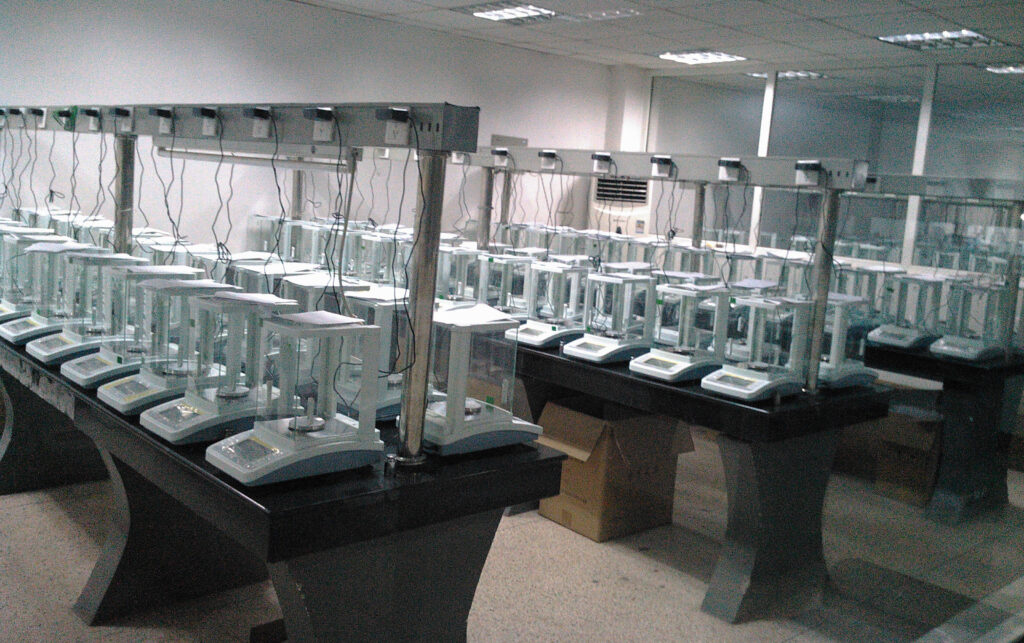1. Put? or not? Even reviewers have different opinions.
In theory, it is best not to put desiccant in the balance. First, it will cause differences in the internal and external environments of the balance; more importantly, the humidity inside the balance will decrease, and static electricity will easily be generated when weighing glassware, and stable readings cannot be obtained, especially in winter.
Think about it, it seems to make sense. Then listen to what the experts say? Unfortunately, even the review experts have different opinions. Experts in medicine think it should be released, while experts in other fields think it is not necessary.

2. Are there relevant regulations at home and abroad?
In the past analytical balances, there were weights inside the photoelectric balance, and moisture (especially the weights) would cause inaccurate weighing. The principle of the current electronic balance is a pressure sensor, which keeps the temperature stable by energizing. If the humidity and temperature inside the balance are different from those outside, will the balance weighed inside be the same as the one used outside?
When the electronic balance is used with a precision of 0.01 mg, desiccant cannot be used. Due to the existence of the desiccant, there will be a slight airflow in the balance, which will make the balance unstable. The inside of the balance should not be too dry, because too dry will cause static electricity.
In short: first, there are installation requirements for electronic balances, and the ambient humidity must be less than 65%; second, there is no express regulation that desiccant must be placed in electronic balances; third, the humidity inside and outside the balance is different, and the air specific gravity is different, which is easy to cause data fluctuations .
Opinion: It is not a matter of principle whether to store it or not. If the environment does not meet the requirements, it is recommended to store it, but it must be taken out when weighing, and it must be replaced frequently. If you strictly abide by the placement conditions of the balance, there is no need to put a desiccant at all. If it is too dry, static electricity will appear instead.
According to an original manufacturer of electronic balances in foreign countries, they got a very clear answer: there is no need to put desiccant such as silica gel inside. Place desiccant. The practice of not putting silica gel is confirmed by the manufacturer.

3. Laboratory temperature and humidity control requirements
The element considered in the control of environmental conditions temperature and humidity is to ensure that the environmental temperature and humidity of the experimental operation can meet the needs of each process of the experimental procedure. We mainly formulate the temperature and humidity control range of the laboratory environment from the following aspects.
(1), identify the requirements of various tasks for environmental temperature and humidity. Mainly identify the needs of instruments, reagents, experimental procedures, and humanized considerations of laboratory staff. The human body generally feels comfortable at a temperature of 18-25°C and a relative humidity of 35-80%.
(2), select and formulate an effective environmental temperature and humidity control range. Extract the narrowest range from the list of all requirements of the above elements as the allowable range of the laboratory’s environmental control, formulate management procedures for environmental condition control, and formulate reasonable and effective SOPs based on the actual situation of the department.
| Reagent chamber | Temperature10-30℃ | Humidity35-80% |
| Sample storage chamber | Temperature10-30℃ | Humidity35-80% |
| Balance chamber | Temperature10-30℃ | Humidity35-65% |
| Moisture chamber | Temperature10-30℃ | Humidity35-65% |
| infrared chamber | Temperature10-30℃ | Humidity35-60% |
| Central laboratory | Temperature10-30℃ | Humidity35-80% |
| Sample chamber | Temperature10-25℃ | Humidity35-70% |
(3), maintain and monitor. Take various measures to ensure that the temperature and humidity of the environment are within the control range, monitor and record the temperature and humidity of the environment, and take timely measures beyond the allowable range, turn on the air conditioner to adjust the temperature, and turn on the dehumidifier to control the humidity.

4. Precautions
(1). Weighing hygroscopic items
When weighing hygroscopic, volatile or corrosive items, the weighing bottle should be tightly capped and weighed as quickly as possible, and be careful not to spill the weighed items (especially corrosive items) on the weighing pan or bottom plate; the same experiment The same balance should be used for weighing to avoid errors due to weighing.
(2)Temperature balance inside the balance
First check whether the windshield is closed. If it is closed, you can start the power-on operation: power on the electronic balance continuously and keep it in the power-on state, and the temperature balance can be formed inside the electronic balance.
(3)Temperature difference will cause airflow
Weighing containers should be as small as possible and plastic weighing containers should be avoided. Keep the weighing container and the sample inside it at the same temperature as the surroundings, as temperature differences can cause drafts and cause a moisture film on the surface of the weighing container and sample. Variety.
At the same time, the weighing container cannot be directly put into the weighing room of the electronic balance by hand, otherwise the temperature and humidity of the weighing room and the weighing container will be changed. It can also have an adverse effect on the weighing process.
(4)The weighing sample should be placed in the middle of the weighing pan to avoid four-corner errors.
For micro and semi-micro electronic balances, the weighing pan is briefly loaded (initial weighing action) after a weighing pause longer than 30 minutes. The weighing sample can be removed from the weighing pan only after the weighing process is completely finished, so as to prevent changes in the temperature and air humidity of the weighing chamber caused by the weighing sample.
5. Correct way
(1) When performing general weighing operations, do not place desiccant in the windshield. Because the existence of the desiccant will cause air convection in the windshield and affect the weighing, and the desiccant will also increase the generation of static electricity. As long as the electronic balance is powered on for a long time, the instrument will automatically volatilize the moisture in the casing, so there is no need to worry about the damage of moisture to the instrument.
(2) When weighing the sample taken out of the desiccator, it needs to be put into the desiccant to balance for a period of time, and then weighed! Because it maintains the same environment as in the desiccator, it is conducive to quick reading and reduces the influence of moisture absorption on the weight of the sample.
(3) If the balance room is equipped with a humidity control device, there is no need to place a desiccant in the windshield at all, and it is enough to control the ambient humidity to be below 65%.
(4) There is no need to put a desiccant on the balance of 1mg or better accuracy. If a desiccant is added when weighing distilled water, the data will definitely be unstable.
6. Conclusion
Here, I would like to remind everyone that in work and study, you can’t always say what to say, just do what you do. Think about everything, why? What is the principle behind it? You will gain a lot!
Having said a lot, some people may say, still don’t know how to do it. There is a reason to put it in, and there is a reason not to let it go. Since there is no express rule that you must not put desiccant, then I put the desiccant in the balance windshield, there is always nothing wrong, right?
Regarding the electronic balance desiccant, in fact, you should know that, as mentioned above, each laboratory with different functions has its own corresponding temperature and humidity requirements, so the overall standard is met, and the use of the balance is basically not affected, but , if the indoor temperature and humidity are not up to standard, the desiccant placed in the balance will actually affect the weighing, won’t it?
Remember: the balance room requires a temperature of 10-30°C and a humidity of 35-65%. There should be no air convection in the electronic balance studio, the workbench should avoid vibration, the room temperature should be kept as stable as possible to avoid temperature drift, and weighing near radiation sources should be prevented.
Most balance users check the compliance of electronic balances through the methods and standards of electronic balance verification specifications. The problem is whether our weighing target (that is, the tolerance of each specific weighing) matches the requirements of the national standard for the balance. In fact, our requirements for weighing errors are either higher or lower than the requirements of national standards for balances. When the national standard is lower than the specific requirements of the weighing task for the balance, a certified balance becomes unreliable.

